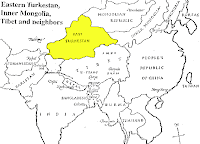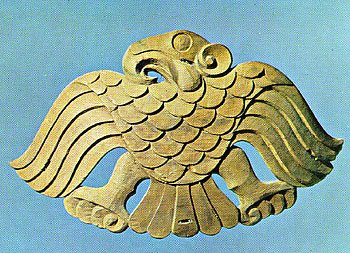Uyghuren

Die Uyghuren (auch: Uyghuren, Uighuren etc.; Eigenbezeichnung: Uyghur; ) sind das größte Turkvolk im Uyghuristan (Uigurischen Autonomen Gebiet ) auch Ostturkestan genannt.Die Uiguren gehören zu den älteren Turkvölkern über 10,000,000. In chinesischen Chroniken erscheinen die Uiguren unter verschiedenen Namen. Am bekanntesten sind: Huihe, Huihu, Weiwu und Chunwei. Die Gesellschaft für bedrohte Völker hat die Uiguren in die Liste der bedrohten Völker aufgenommen.

Namensbedeutung Erste Stammesnamen der späteren Uiguren wurden schon bei den Xiongnu erwähnt, als diese Ost-Turkestan und Gansu unterwarfen.Die Uiguren sind ursprünglich westtürkischer Herkunft. Sie zählten zu den ogurischen Stämmen. Der Volksname setzt sich aus dem alttürkischen Wörtern uy = folgen, gehorsam und ghur zusammen. Es ist also eine Verballhornung des Namens Uy(o)ghur ? Uy-Ogur ? gehorsamer, folgsamer Ogure.Eine andere Bedeutung des Namens könnte sich auch von der Tatsache ableiten, dass die Uiguren als erstes Turkvolk Städte errichteten und bedeutenden Handel trieben.(türkisch: uygar)Nach anderer Meinung leitet sich das türkische Wort "uygar" vom Volksnamen "Uyghur" ab.
Verbreitung Die Muttersprache der Uiguren ist die Uyghurische Sprache. Nach der Volkszählung im Jahre 1990 leben in der Volksrepublik China 7.214.431 Uiguren, davon 99,73% im Uigurischen Autonomen Gebiet Xinjiang. Weitere 5.739 leben in Hunan, 2.021 in Beijing (Peking).

Im Jahre 1990 dienten 4.756 Uiguren in der Volksbefreiungsarmee als Soldaten und Offiziere.Etwa 300.000 Uiguren (so genannte Ili-Türken) leben in Kasachstan. Kleinere Minderheiten gibt es in der Mongolei, in der Türkei, in Afghanistan und weiteren Teilen Zentralasiens.Größere Gruppen leben auch in Deutschland, Pakistan, Indonesien, Australien, Taiwan und Saudi-Arabien.
Religion Die Mehrheit der Uiguren gehört dem sunnitischen Islam an.
Geschichte Bereits um 300 wurden vereinzelte Stämme der Xiongnu erwähnt, die später mit anderen mongolischen und tungusischen Völkerschaften zum neuen Stamm der Uiguren zusammenwuchsen.
AufstiegHerausgebildet hat sich das eigentliche Uiguren-Volk erst seit dem 4./5. Jahrhundert aus der Verschmelzung früherer turko-mongolischer Gruppen: Die Huihe (?? huíhé) und die Tie'le-Gemeinschaft werden unter anderem genannt. Die Uiguren waren ursprünglich im Orchon- und Selengatal ansässig. Dort hatten sie die Sekiz-Oghusen im Osten und die Dokuz-Oghusen im Norden und Nordwesten zu Nachbarn.Erster geschichtlich belegter Herrscher war Ay Uzhru (reg. 487-508), der den Staat Uyghuristan begründete. Er stand dem Yaghlaqar-Klan vor, der die Oberherrschaft über die neun übrigen Klans ausübte und mit dem alten Xiongnu-Klan Aschina eng verwandt war.Zeitgenössische chinesische Quellen bezeichnen die Uiguren auch als Jiuxing, als Neun Stämme. Dieses ist wahrscheinlich als eine Übernahme des ehemaligen Stammesnamens der 9 Oghusen anzusehen. Die muslimischen Geschichtsschreiber jener Zeit fassten die Uiguren stets unter der Sammelbezeichnung 9 Oghusen zusammen.In der Regierungszeit des Begchi (reg. 537-41) fielen 541 auch die Uiguren unter die Herrschaft der Rouran. Der Göktürken-Herrscher Bumin/Tuman schloss die Uiguren 546/50 gewaltsam an sein entstehendes Großreich an.

Das Großreich der UigurenIm Jahre 605 wurde das Reich der Orchon-Uiguren gegründet, als sich Shigan-Sygin formal von den Göktürken unabhängig machte.681 wurde ihr Herrscher Toghuchi von den Göktürken unterworfen und die Orchon-Uiguren kehrten in den Reichsverband zurück.Unter Iltimis Kutluq Bilge-Kül erhoben sich 744-45 die Uiguren gegen den herrschenden Turkut-Stamm der Göktürken. Dabei arbeiteten die Uiguren zunächst im Bündnis mit den späteren Karluken (diese galten zu jener Zeit den Uiguren zugehörig und waren teilweise mit ihnen im Verband der On-Oq eingegliedert), Basmilen, Türgesch und Otuz-Oghusen und führten einen blutigen Umsturz herbei. Er beseitigte den letzten Herrscher des Göktürken-Reiches, Bomei Khagan. , 8./9. Jh.]], 8./9. Jh.]]So entstand ein Großreich in der heutigen Mongolei (745-840). Dabei übten die Uiguren eine Art Oberherrschaft über benachbarte und engverwandte Gruppen wie Basmilen, Karluken, Türgesch, Sekiz-Oghusen, Dokuz-Tataren, Kitan und Kirgisen aus. Man verzeichnete Ackerbau und einige Städte bis hinein nach Tannu-Tuwa. Schließlich herrschten die Uiguren über neun Stämme, die sowohl den West- als auch den Osttürken angehörten. Als erstes Zentrum ihrer Macht hatten die Uiguren Char balgas (auch Kara Balgasun oder Karabalgasun) zur Hauptstadt.Die eigentlichen Uiguren wurden von den folgenden Stämmen gebildet, von denen größtenteils auch die chinesischen Bezeichnungen bekannt sind:* Uange* Uturqar ? Hu-tu-ko * Kürebir ? Hu oder Kiu-lo-vo * Bagas?g?r ? Mo-ko-si-ki* Elbirçek oder Albyrçak? ? A-vu-chö Yagmar ? Hu-vu-su oder Yo-vu-ku * Ayvarir ? Hu-ye-vu (verschiedene Oghusen-Emire)* Bayegu, Pugu oder Buku ? P'u-kuHun ? Qun * Bay?rku ? Pa-ye-ku* Tongra ? T'ung-h* S?qar ? Sse-kie* Po-si oder Si? ? K'i-pi oder A-pu-sse* Ediz ? K-vu-ku oder A-tiBereits unter den Söhnen Iltemis (Bilge-Kül [reg. 747-59] und Tengri [reg. 759-79]) wurde das Reich alten Traditionen entsprechend geteilt. Die Hauptstadt der Osthälfte war das mongolische Char balgas, das sich am Ostufer des Orchon befand. Dessen Ruinen sind zwischenzeitlich ausgegraben und durch eine zwölf Meter hohe Festungsmauer berühmt geworden. Dort lebten damals bis zu 100 000 Menschen. Als Hauptstadt des Westreiches galt Tofar.Vor allem unter Bilge-Kül erreichte das junge Uigurenreich seine größte Macht. Dessen Söldnerdienste für China und die übrige chinafreundliche Politik des Uigurenreiches führten dazu, dass Tengri 762 nach China kam und dort, mit dem Großteil des Adels, zum Manichäismus übertrat. Aber auch die Assyrische_Kirche und der Buddhismus breiteten sich im Reich aus. Dadurch wurde es den Uiguren ermöglicht, den Handel mit dem christlichen Morgenland auszubauen. Sie übernahmen nun die syrisch-aramäische Schrift und bildeten in der Folgezeit ein bedeutendes Schrifttum aus, wie zum Beispiel das Werk Kutadgu Bilik des Yusuf Has Haaib, das in den Jahren 1069 bis 1070 entstand.Mit der Übernahme des Christentums wurde das Uigurenreich zu einem Zufluchtsort der christlichen Soghder, die rasch zu Einfluss am Hofe gelangten und vor allem die Außenpolitik beherrschten. Dort versuchten sie, die Politik von China ab- und den christlichen Staaten zu zuwenden. Der Handel und die Religion wurde bei den Uiguren gepflegt, das Kriegshandwerk jedoch nicht: Als treue Christen war ihnen dieses ja von der Religion verboten worden.Eine Besonderheit des uigurischen Staates war, dass der Khagan und dessen Stellvertreter, der Shad oder Schad (türkisch: ?ad), dem staatstragenden Volk der Soghder entstammten. Dadurch wirkte das Uigurenreich nicht so diktatorisch wie all seine Vorgängerreiche.Doch Teile des Adels waren mit der Politik der Soghder nicht einverstanden. So kam es unter der Führung des Tun Baga Tarkhan zum Aufstand des Adels und Tarkhan ordnete die Ermordung (779) seines Vetters Tengri Khagan an, als dieser sich weigerte, die Soghder zu entmachten. Tarkhan nahm nun den Titel Alp-Kutluq Bilge an. Alp-Kutluq richtete seine Politik wieder nach China aus und ließ zahlreiche Christen ermorden.
Niedergang des Großreiches788 wurde Alp-Kutluq von China nicht mehr als Jüngerer Brüder ? Söldner, sondern als Halb/Schwiegersohn ? enger Freund bezeichnet.Nach dem Tode Alp-Kutluqs (789) verloren die Uiguren vorübergehend an politischem Einfluss. Nachfolger wurde nun Külüg-Bilge (reg. 789/90) und bereits 790 wurde der minderjährige Bruder Kutluq-Bilge (790/95) zum Herrscher ausgerufen. Doch lag die wahre Macht bei General Kutluq, der allerdings als erfolglos galt: Sämtliche Feldzüge des Jahres 790 gingen für Kutluq verloren. Doch 795 starb Külüg-Bilge ohne einen Nachfolger zu hinterlassen. General Kutluq nahm nun den Namen Ay-Tengride Ülüg-Bulmis Alp-Kutluq Ulugh-Bilge (reg. 795-805) an und übernahm die Macht. (Bereits 791 konnte er die Schmach von 790 ausbügeln, indem er die Stadt Beschbalyk von den Tibetern erobern und ihren Außenposten vernichten konnte.)Ay-Tengride stellte die Macht des Uigurenreiches wieder her, wovon seine Nachfolger, Ay-Tengride Kut-Bulmis Külüg-Bilge (reg. 805-08) und Ay-Tengeride Kut-Bulmis Alp-Bilge (reg. 808-21), noch lange zehren konnten. Der Nachfolger des letzteren, Kün-Tengride Ülüg-Bulmis Alp-Küchlüg- Bilge (reg. 821-24) baute die guten chinesisch-uigurischen Beziehungen weiter aus, allerdings warfen die ständigen Einfälle uigurischer Horden in China dunkle Schatten auf diese Beziehungen. China war mit seinen Belohnungen für die Hilfsdienste der Uiguren nicht mehr so großzügig wie einst: Ay-Tengride Kut-Bulmis Alp-Bilge (reg. 824-32) musste sich mit der bescheidenen Erlaubnis, Pferdehandel treiben zu dürfen und mit ein paar Ballen Seide zufrieden geben.
Ende des StaatswesensSchließlich kam es zum blutigen Aufstand gegen die Herrscher-Dynastie und Alp-Bilge wurde 832 von seinen engsten Ministern ermordet.Nachfolger wurde nun Ay-Tengeride Kut-Bulmis, Alp-Külüg Bilge (reg. 832-39) galt als schwacher Herrscher, der zusehen musste, wie sein Minister Kürebir die Scha-t'o (eine Stammesföderation aus drei Stämmen) gegen ihn einsetzte. Alp-Külüg Bilge beging darauf hin Selbstmord.Ein strenger Winter und innenpolitischer Verrat schwächten 839/40 das Reich in der Mongolei, so dass es schließlich durch einen Angriff der Jenissej-Kirgisen zugrunde ging: 839 zog sich der uigurische General und Aufrührer Külüg Bagha zu den mit den Uiguren verfeindeten Kirgisen zurück. Die Kirgisen plagten die Uiguren schon seit 20 Jahren immer wieder mit Grenzverletzungen und bereits im Jahre 840 überfielen die 40 Stämme der Kirgisen mit 100.000 Kriegern die Städte Tofar, Char balgas und Ordu Balyk. Daraufhin entflammte ein blutiger Krieg zwischen beiden Völkern. Anführer der Kirgisen waren damals Uje Khan (gest. 847) und eben dieser Külüg Bagha. Im Verlaufe dieses Krieges wurde dann beispielsweise auch die Stadt Char balgas von den Kirgisen vollkommen zerstört.
Am Ende war das Uigurenreich vollständig zerschlagen, ihre Herrscher Kichik-Tegin (reg. 839-40) und Ughe-Tegin (reg. 840-46) wurden getötet und die Kirgisen traten deren Erbe an.Nach dem Niedergang ihres Reiches wurden die Uiguren durch die Kirgisen in alle Richtungen zerstreut. Das Gros der Uiguren gründete jedoch zwei kleinere Staaten im heutige Uyghuristan (856) und in der heutigen Provinz Gansu. Die Uiguren wurden nun endgültig sesshaft, vermischten sich mit ihren Nachbarn in einer Stadtkultur und lehnten eine Rückkehr in die mongolische Steppe ab. Der Uigurenstaat in Gansu wurde 1028-36 von den Tanguten übernommen. Der Uigurenstaat Uyghuristan im heutigen Xinjiang (Zentrum Beschbalyk, Turfan) wurde circa 1130 von den Kara_Kitai, 1209 von den Mongolen abhängig und ging im 14. Jahrhundert zugrunde. Trotzdem strahlte ihr kultureller Einfluss (ihre Schrift, Verwaltung und so weiter) bis zur heutigen Zeit auf die Nachbarn aus. Johannes de Piano Carpini berichtete im 13. Jh. über die Eroberung der Uighuren durch Dschingis Khan: ?Diese Menschen sind Christen von der Sekte der Nestorianer... Die Mongal übernahmen ihre Schrift, denn vorher hatten sie nicht geschrieben; nun aber nennen sie diese als die mongolische Schrift? (Johannes von Plano Carpini: Kunde von den Mongolen, übers. v. F. Schmiederer, Sigmaringen 1997, S. 62.) Etwa zur Mitte des 13. Jahrhundert setzte sich der Islam bei den Uiguren im heutigen Xinjiang durch (1252/5 Anklage und Hinrichtung des buddhistischen Herrschers Idiqut Salendi wegen nachgewiesener "Islamfeindlichkeit").
Literatur * Dru C. Gladney: Dislocating China: Muslims, Minorities and Other Sub-altern Subjects, 2004 ISBN 1850653240* Elcin Kürsat-Ahlers: Zur frühen Staatenbildung von Steppenvölkern - Über die Sozio- und Psychogenese der eurasischen Nomadenreiche am Beispiel der Hsiung-Nu und Göktürken mit einem Exkurs über die Skythen (Sozialwissenschaftliche Schriften Heft 28). Duncker & Humblot, Berlin 1994. 450 S.. ISBN 3-428-07761-X, ISSN 0935-4808.* S. Frederick Starr: Uyghuristan: China's Muslim Borderland, 2004 ISBN 0765613182* U.S. Congressional-Executive Commission on China: Ethnic Minorities in China: Tibetans and Uighurs, 2002 ISBN 0160687535

Weblinks • Zentralasienforschung• Uiguren (englisch)• Interessantes und Aktuelles aus Ostturkestan• Hintergrundbericht von Human Rights Watch zu Geschichte und aktueller Lage der Uiguren (pdf)• Die Uiguren-Nationalität (chinesische Regierungsseite auf Deutsch)• Weltweites Uigurisches Nachrichten Netz (uygur.org)• Uiguren (Gesellschaft für bedrohte Völker)









